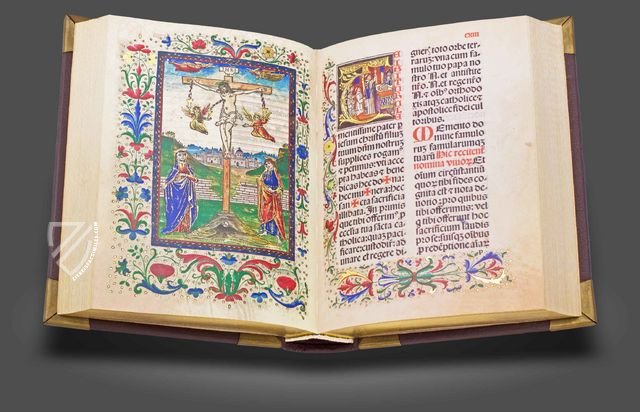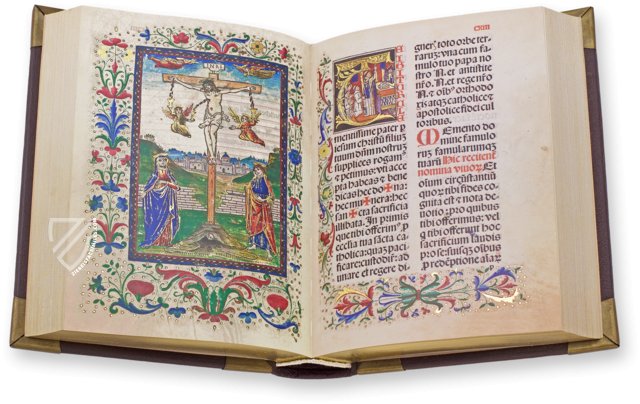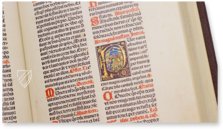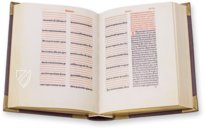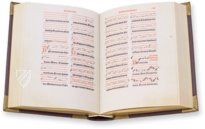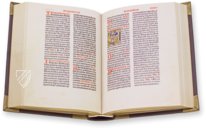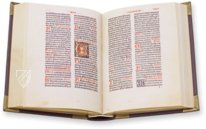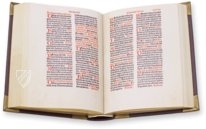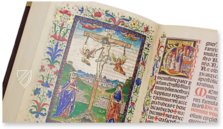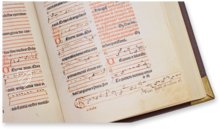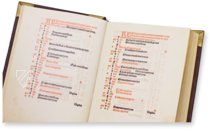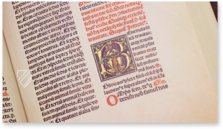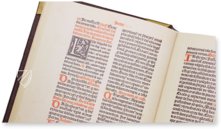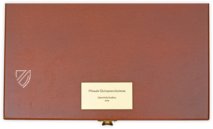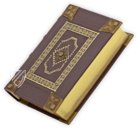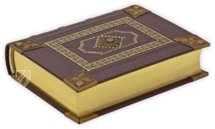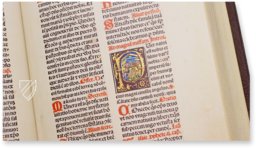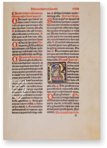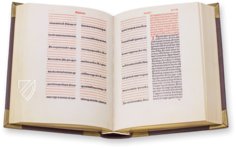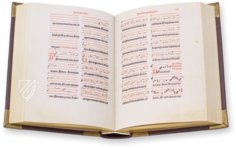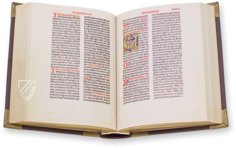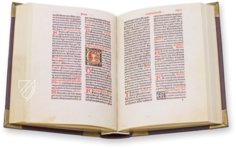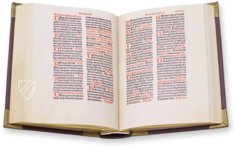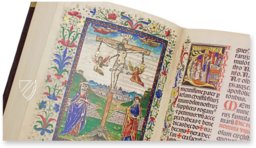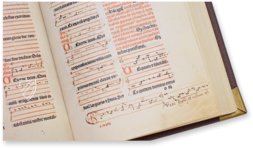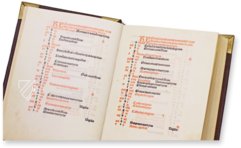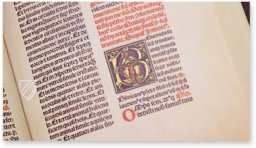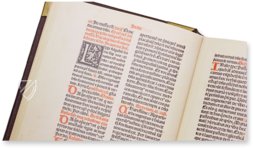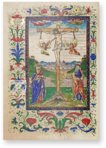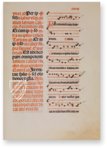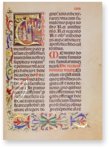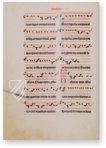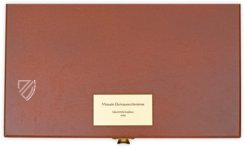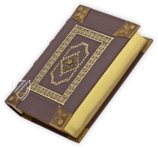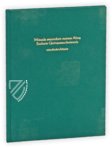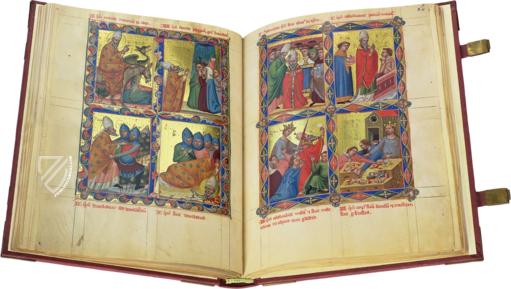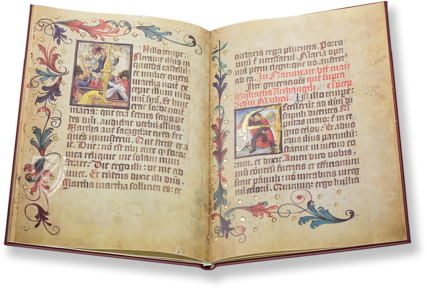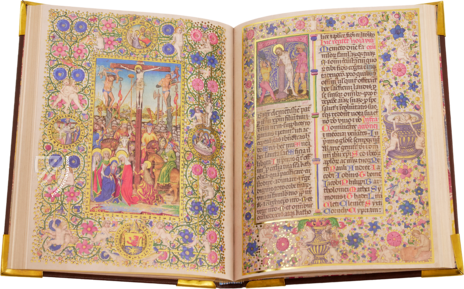Missale Quinqueecclesiense
(1,000€ - 3,000€)
Originally printed in Basel in 1487, the Missale Quinqueecclesiense contains the missal commissioned by the Bishop Zsigmond Ernuszt of Pécs. The second, more artfully adorned edition was published in the Venetian print shop of Johannes Emericus de Spira, a native of Speyer, on 24 April 1499 – the feast of St. George the Dragon Slayer. It was commissioned by Johannes Paep, a bookseller from Buda, on the behalf of the aforementioned humanist bishop presumably because the first edition was insufficient in number to meet demand.
Printed in red and black ink, vellum copies of the work were adorned with woodcuts, which were then colored by hand in Buda. These woodcuts include biblical scenes, decorative initials, and floral frames, some of which were adorned with gold. The copy known as the Pécs Missal has had a tumultuous and often mysterious history that is closely tied with the history of Hungary from the Turkish occupation to the Cold War. Furthermore, it contains descriptions of unique local rites which give an insight into the everyday life and customs of the religious people of Pécs during the Middle Ages.
Missale Quinqueecclesiense
After the closure of the first printing press in Buda in 1473, Hungarian booksellers were forced to look to German, Austrian, French, and Italian printers to meet their needs. Before the adoption of the uniform Roman Missal in 1630, Hungarian dioceses used their own missals with specific features such as special rites and the veneration of local saints. This is also true of the medieval Diocese of Pécs, which published two editions of its own missal in the last decades of the 15th century: the Missale Quinqueecclesiense, also known as the Pécs Missal. Aside from being an exemplary work of book art, it provides insight into the everyday life and customs of the religious people of Pécs during the Middle Ages.
The first, less ornate edition was published in Basel by Michael Wenssler (ca. 1445–1512) at the behest of the humanist Bishop Zsigmond Ernuszt of Pécs (1473–1505). It was followed by a second edition that was commissioned by an antiquarian and bookseller from Buda named Johannes Paep on behalf of the Bishop of Pécs and published in Venice by Johann Emerich (d. 1499), also known as Johannes Emericus de Spira, a native of Speyer, on the 24th of April 1499, the feast of St. George the Dragon Slayer. Emerich’s tasteful and finely engraved missals, produced for several dioceses in Hungary, were very popular. Interestingly, although Paep was one of Emerich’s regular clients, the printer consistently omitted his name from the colophon of the prints he produced for him.
Design of the Missal
The Pécs Missal was printed in two colors: black for the text and red for the rubrics. Three decorated parchment copies and one unadorned paper copy survive today. Expensive vellum editions such as this were adorned with woodcut initials as well as hand-painted miniatures and decorative floral frames, which were illuminated with gold leaf. The similarity of the decoration of the surviving copies suggests that they were all made in an atelier in Buda that closely followed the style of the Florentine master Attavante degli Attavanti (1452–1525). It is remarkable how well integrated the printed and handmade elements of the codex are in this exceptional example of an incunable.
An Adventurous History
It is reasonable to assume that several copies of the missal existed in Pécs before it was occupied by the Ottoman Turks in 1543. What happened to these codices and this copy in particular between then and the liberation of the city by the army of the Holy Roman Empire in 1686 remains unknown, but somehow it survived.
Bishop György Klimó (1710–77) learned from historical sources about the existence of the late 15th century Pécs missal in Kassa and wrote a letter dated the 15th of September 1768 to the Canon of Eger requesting a volume containing important aspects of the history of Pécs' rituals. A copy arrived in Pécs in the spring of 1769 with the approval of Bishop Károly Eszterházy of Eger (1761-1799), and from then on it enriched the collection of the Pécs Episcopal Library, which was made public in 1774.
Its temporary location in Cassovia is indicated by the first inscription on the frontispiece: Missale Civitatis Cassoviensis, which complicated the identification of the volume for a long time. The three parchment copies are all incomplete, but fortunately all of their existing parts complement one another so that a facsimile of a complete copy of the missal could be created.
Codicology
- Alternative Titles
- Missale Civitatis Cassoviensis
Pécsi Missale
Pécs Missal 1499
Second Pécs Missal
Missale secundum morem Alme Ecclesie Quinqueecclesiensis - Size / Format
- 588 pages / 28-32 × 20-24 cm
- Origin
- Italy
- Date
- 1499
- Epochs
- Style
- Genre
- Language
- Illustrations
- Poignant full-page miniatures and historiated initials, bordures with vegetal elements
- Content
- Missal
- Patron
- Johannes Paep (bookseller in Buda) for
Sigismund Ernuszt (Bishop of Pécs) - Artist / School
- Printer: Johann Emerich
- Previous Owners
- György Klimo (bishop of Pécs)
#1 Pécsi Missale
Language: Hungarian
(1,000€ - 3,000€)
- Treatises / Secular Books
- Apocalypses / Beatus
- Astronomy / Astrology
- Bestiaries
- Bibles / Gospels
- Chronicles / History / Law
- Geography / Maps
- Saints' Lives
- Islam / Oriental
- Judaism / Hebrew
- Single Leaf Collections
- Leonardo da Vinci
- Literature / Poetry
- Liturgical Manuscripts
- Medicine / Botany / Alchemy
- Music
- Mythology / Prophecies
- Psalters
- Other Religious Books
- Games / Hunting
- Private Devotion Books
- Other Genres
- Afghanistan
- Armenia
- Austria
- Belgium
- Belize
- Bosnia and Herzegovina
- China
- Colombia
- Costa Rica
- Croatia
- Cyprus
- Czech Republic
- Denmark
- Egypt
- El Salvador
- Ethiopia
- France
- Germany
- Greece
- Guatemala
- Honduras
- Hungary
- India
- Iran
- Iraq
- Israel
- Italy
- Japan
- Jordan
- Kazakhstan
- Kyrgyzstan
- Lebanon
- Liechtenstein
- Luxembourg
- Mexico
- Morocco
- Netherlands
- Palestine
- Panama
- Peru
- Poland
- Portugal
- Romania
- Russia
- Serbia
- Spain
- Sri Lanka
- Sweden
- Switzerland
- Syria
- Tajikistan
- Turkey
- Turkmenistan
- Ukraine
- United Kingdom
- United States
- Uzbekistan
- Vatican City
- A. Oosthoek, van Holkema & Warendorf
- Aboca Museum
- Ajuntament de Valencia
- Akademie Verlag
- Akademische Druck- u. Verlagsanstalt (ADEVA)
- Aldo Ausilio Editore - Bottega d’Erasmo
- Alecto Historical Editions
- Alkuin Verlag
- Almqvist & Wiksell
- Amilcare Pizzi
- Andreas & Andreas Verlagsbuchhandlung
- Archa 90
- Archiv Verlag
- Archivi Edizioni
- Arnold Verlag
- ARS
- Ars Magna
- ArtCodex
- AyN Ediciones
- Azimuth Editions
- Badenia Verlag
- Bärenreiter-Verlag
- Belser Verlag
- Belser Verlag / WK Wertkontor
- Benziger Verlag
- Bernardinum Wydawnictwo
- BiblioGemma
- Biblioteca Apostolica Vaticana (Vaticanstadt, Vaticanstadt)
- Bibliotheca Palatina Faksimile Verlag
- Bibliotheca Rara
- Boydell & Brewer
- Bramante Edizioni
- Bredius Genootschap
- Brepols Publishers
- British Library
- C. Weckesser
- Caixa Catalunya
- Canesi
- CAPSA, Ars Scriptoria
- Caratzas Brothers, Publishers
- Carus Verlag
- Casamassima Libri
- Centrum Cartographie Verlag GmbH
- Chavane Verlag
- Christian Brandstätter Verlag
- Circulo Cientifico
- Club Bibliófilo Versol
- Club du Livre
- CM Editores
- Collegium Graphicum
- Collezione Apocrifa Da Vinci
- Comissão Nacional para as Comemorações dos Descobrimentos Portugueses
- Coron Verlag
- Corvina
- CTHS
- D. S. Brewer
- Damon
- De Agostini/UTET
- De Nederlandsche Boekhandel
- De Schutter
- Deuschle & Stemmle
- Deutscher Verlag für Kunstwissenschaft
- DIAMM
- Droz
- E. Schreiber Graphische Kunstanstalten
- Ediciones Boreal
- Ediciones Grial
- Ediclube
- Edições Inapa
- Edilan
- Editalia
- Edition Deuschle
- Edition Georg Popp
- Edition Leipzig
- Edition Libri Illustri
- Editiones Reales Sitios S. L.
- Éditions de l'Oiseau Lyre
- Editions Medicina Rara
- Editorial Casariego
- Editorial Mintzoa
- Editrice Antenore
- Editrice Velar
- Edizioni Edison
- Egeria, S.L.
- Eikon Editores
- Electa
- Emery Walker Limited
- Enciclopèdia Catalana
- Eos-Verlag
- Ephesus Publishing
- Ernst Battenberg
- Eugrammia Press
- Extraordinary Editions
- Fackelverlag
- Facsimila Art & Edition
- Facsimile Editions Ltd.
- Facsimilia Art & Edition Ebert KG
- Faksimile Verlag
- Feuermann Verlag
- Folger Shakespeare Library
- Franco Cosimo Panini Editore
- Friedrich Wittig Verlag
- Fundación Hullera Vasco-Leonesa
- G. Braziller
- Gabriele Mazzotta Editore
- Gebr. Mann Verlag
- Gesellschaft für graphische Industrie
- Getty Research Institute
- Giovanni Domenico de Rossi
- Giunti Editore
- Graffiti
- Grafica European Center of Fine Arts
- Guido Pressler
- Guillermo Blazquez
- Gustav Kiepenheuer
- H. N. Abrams
- Harrassowitz
- Harvard University Press
- Helikon
- Hendrickson Publishers
- Henning Oppermann
- Herder Verlag
- Hes & De Graaf Publishers
- Hoepli
- Holbein-Verlag
- Houghton Library
- Hugo Schmidt Verlag
- Idion Verlag
- Il Bulino, edizioni d'arte
- ILte
- Imago
- Insel Verlag
- Insel-Verlag Anton Kippenberger
- Instituto de Estudios Altoaragoneses
- Instituto Nacional de Antropología e Historia
- Istituto dell'Enciclopedia Italiana - Treccani
- Istituto Ellenico di Studi Bizantini e Postbizantini
- Istituto Geografico De Agostini
- Istituto Poligrafico e Zecca dello Stato
- Italarte Art Establishments
- Jan Thorbecke Verlag
- Johnson Reprint Corporation
- Josef Stocker
- Josef Stocker-Schmid
- Jugoslavija
- Karl W. Hiersemann
- Kasper Straube
- Kaydeda Ediciones
- Kindler Verlag / Coron Verlag
- Kodansha International Ltd.
- Konrad Kölbl Verlag
- Kurt Wolff Verlag
- La Liberia dello Stato
- La Linea Editrice
- La Meta Editore
- Lambert Schneider
- Landeskreditbank Baden-Württemberg
- Leo S. Olschki
- Les Incunables
- Liber Artis
- Library of Congress
- Libreria Musicale Italiana
- Lichtdruck
- Lito Immagine Editore
- Lumen Artis
- Lund Humphries
- M. Moleiro Editor
- Maison des Sciences de l'homme et de la société de Poitiers
- Manuscriptum
- Martinus Nijhoff
- Maruzen-Yushodo Co. Ltd.
- MASA
- Massada Publishers
- McGraw-Hill
- Metropolitan Museum of Art
- Militos
- Millennium Liber
- Müller & Schindler
- Nahar - Stavit
- Nahar and Steimatzky
- National Library of Wales
- Neri Pozza
- Nova Charta
- Oceanum Verlag
- Odeon
- Orbis Mediaevalis
- Orbis Pictus
- Österreichische Staatsdruckerei
- Oxford University Press
- Pageant Books
- Parzellers Buchverlag
- Patrimonio Ediciones
- Pattloch Verlag
- PIAF
- Pieper Verlag
- Plon-Nourrit et cie
- Poligrafiche Bolis
- Presses Universitaires de Strasbourg
- Prestel Verlag
- Princeton University Press
- Prisma Verlag
- Priuli & Verlucca, editori
- Pro Sport Verlag
- Propyläen Verlag
- Pytheas Books
- Quaternio Verlag Luzern
- Reales Sitios
- Recht-Verlag
- Reichert Verlag
- Reichsdruckerei
- Reprint Verlag
- Riehn & Reusch
- Roberto Vattori Editore
- Rosenkilde and Bagger
- Roxburghe Club
- Salerno Editrice
- Saltellus Press
- Sandoz
- Sarajevo Svjetlost
- Schöck ArtPrint Kft.
- Schulsinger Brothers
- Scolar Press
- Scrinium
- Scripta Maneant
- Scriptorium
- Shazar
- Siloé, arte y bibliofilia
- SISMEL - Edizioni del Galluzzo
- Sociedad Mexicana de Antropología
- Société des Bibliophiles & Iconophiles de Belgique
- Soncin Publishing
- Sorli Ediciones
- Stainer and Bell
- Studer
- Styria Verlag
- Sumptibus Pragopress
- Szegedi Tudomànyegyetem
- Taberna Libraria
- Tarshish Books
- Taschen
- Tempus Libri
- Testimonio Compañía Editorial
- Thames and Hudson
- The Clear Vue Publishing Partnership Limited
- The Facsimile Codex
- The Folio Society
- The Marquess of Normanby
- The Richard III and Yorkist History Trust
- Tip.Le.Co
- TouchArt
- TREC Publishing House
- TRI Publishing Co.
- Trident Editore
- Tuliba Collection
- Typis Regiae Officinae Polygraphicae
- Union Verlag Berlin
- Universidad de Granada
- University of California Press
- University of Chicago Press
- Urs Graf
- Vallecchi
- Van Wijnen
- VCH, Acta Humaniora
- VDI Verlag
- VEB Deutscher Verlag für Musik
- Verlag Anton Pustet / Andreas Verlag
- Verlag Bibliophile Drucke Josef Stocker
- Verlag der Münchner Drucke
- Verlag für Regionalgeschichte
- Verlag Styria
- Vicent Garcia Editores
- W. Turnowski Ltd.
- W. Turnowsky
- Waanders Printers
- Wiener Mechitharisten-Congregation (Wien, Österreich)
- Wissenschaftliche Buchgesellschaft
- Wissenschaftliche Verlagsgesellschaft
- Wydawnictwo Dolnoslaskie
- Xuntanza Editorial
- Zakład Narodowy
- Zollikofer AG

